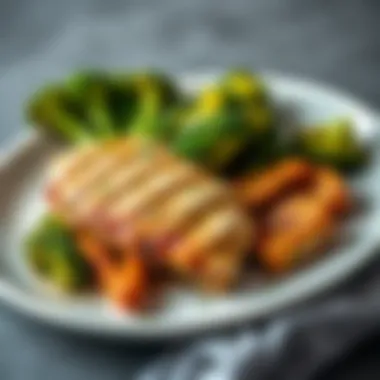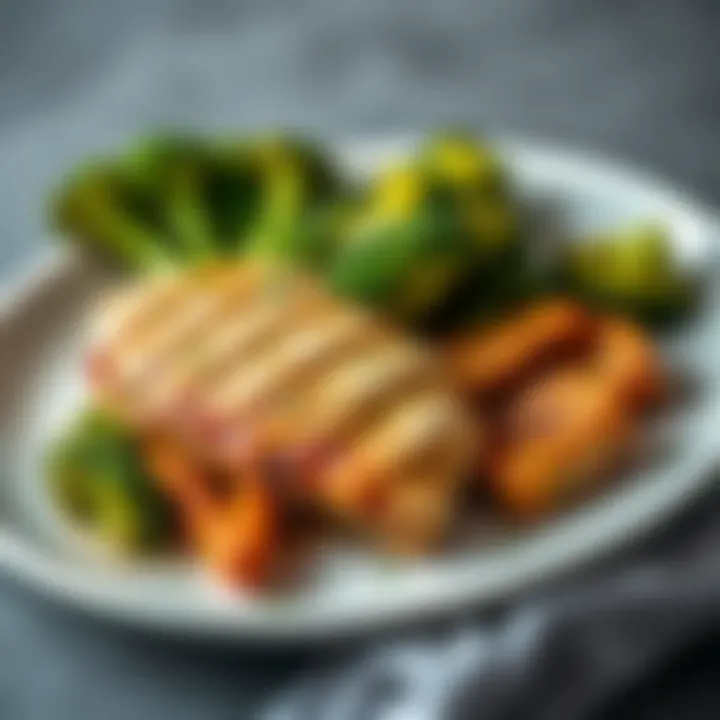Effective Lunch Choices for Losing Weight


Intro
When it comes to shedding those extra pounds, lunch can play a pivotal role in your journey. It’s more than just a midday refueling; it's an opportunity to refocus your dietary choices and bolster your weight loss efforts. Unfortunately, many people fall into the trap of quick fixes and fast food, leading to choices that might be convenient but do little to support their health goals. This article will shine a light on what makes for optimal lunch choices in the context of weight loss. Understanding ingredients and how they interact with your body is key. This guide is crafted for everyone—whether you're a meal prep pro or just starting your culinary journey.
Recipe Overview
Recipe Name
Mediterranean Quinoa Salad
Cuisine Type
Mediterranean
Ingredients
List of Ingredients with Measurements
- 1 cup quinoa (uncooked)
- 2 cups water or vegetable broth
- 1 cup cherry tomatoes, halved
- 1 cucumber, diced
- 1 bell pepper, diced
- 1/4 cup red onion, finely chopped
- 1/4 cup feta cheese, crumbled (optional)
- 1/4 cup olives, sliced
- 2 tablespoons olive oil
- 1 tablespoon lemon juice
- Salt and pepper to taste
- Handful of fresh parsley, chopped
Substitutions for Common Ingredients
- Quinoa can be replaced with farro or brown rice for different textures and flavors.
- Feta cheese is optional, but for a vegan option, use tofu or skip it entirely.
- If you're not keen on olives, consider adding capers for a similar salty flavor.
The Mediterranean Quinoa Salad exemplifies the approach to a balanced meal—high in fiber, protein, and nourishing fats while keeping things light. With the protein-rich quinoa, fresh vegetables, and healthy fats from olive oil, this dish not only fuels your day but also helps keep cravings at bay.
Portion control is important, as a generous serving here can still fit snugly into your weight loss plan. Preparing such meals in advance can save you from the pitfalls of last-minute decisions and help you stay on track with your goals.
Benefits of Mediterranean Ingredients
Eating a variety of whole foods and fiber-rich components not only aids in weight loss but also boosts your mood and energy levels.
Remember, when choosing lunch options, think about balance. It’s essential to incorporate both macronutrients and micronutrients to maintain satiety and energy levels throughout the day. Focus on meals that nourish your body while helping you move closer to your fitness aspirations.
Some useful resources for further reading on meal planning and weight loss include nutrition.gov and harvard.edu. By understanding what goes into your meals, you can play a proactive role in your health!
Stay tuned for more sections where we dive deeper into meal planning and the intricacies of making effective choices.
Understanding Weight Loss Principles
Understanding the principles behind weight loss is essential for anyone looking to shed pounds effectively. It’s not just about what you eat but also how your body processes energy, what types of food you choose, and when you consume them. With a grasp on these fundamental elements, individuals can make more informed choices that align closely with their weight loss journey.
One of the core tenets of losing weight revolves around creating a caloric deficit, which means consuming fewer calories than you burn. This simple yet powerful concept serves as a foundation for any successful weight loss strategy. By paying attention to what goes on your plate and ensuring that the energy you expend outweighs the energy you take in, you can make significant strides toward your goals.
Another crucial aspect is understanding the role of macronutrients—proteins, fats, and carbohydrates—in your meals. Each plays a unique role in satiety, metabolism, and overall health. Pairing the right macronutrients can enhance your meal's impact on weight loss, helping you feel full while maintaining energy levels.
Meal timing also deserves consideration in this discussion. Eating patterns can affect metabolism and hunger signals. An optimal schedule may help in sustaining energy levels throughout the day, making it easier to stick to a healthy eating regimen.
"When you understand weight loss principles, you're not just following a diet—you're embarking on a lifestyle change."
All in all, recognizing these principles helps you navigate your weight loss journey more effectively, allowing for sustainable habits rather than short-term fixes.
Identifying Suitable Lunch Ingredients
When it comes to shedding those extra pounds, selecting the right ingredients for your lunch can be a game changer. A careful consideration of what goes into your meal not only affects your immediate satisfaction but also your long-term progress in weight management. The aim here is to combine hunger-filling elements with nutritious components to create a lunch that keeps you satisfied and nourished without tipping the scales.
Lean Proteins for Sustained Energy
Lean proteins are a cornerstone of healthy eating, particularly for those looking to lose weight. They play a vital role in muscle maintenance and help keep you feeling full longer. Chicken breast, turkey, and fish such as cod or tilapia are excellent options. These proteins are low in fat and high in amino acids, necessary for repairing tissues and promoting overall health. Consuming lean proteins may incorporate a sense of satiety that helps you resist reaching for unhealthy snacks later in the day.
High-Volume Vegetables
Vegetables, particularly those that are high in volume but low in calories, should be central to any weight-loss lunch. These foods add bulk to your meal and are often packed with vital nutrients.
Leafy Greens
Leafy greens like spinach, kale, and romaine are well-known for their nutritional punch. They are low in calories while being high in fiber, which means you can eat a hearty portion without worrying about caloric intake. The high fiber content in leafy greens not only helps digestion but also assists in maintaining steady energy levels throughout the day. They are frequently found in salads, wraps, and even smoothies, making them a versatile addition to any meal.


With leafy greens, you're not just eating, you're also nourishing your body from the inside out.
Cruciferous Vegetables
Cruciferous vegetables, such as broccoli, cauliflower, and Brussels sprouts, are another great choice. They are high in fiber and provide vitamins C and K. Adding these veggies to your lunch can enhance your meal's fiber content, helping to keep blood sugar levels stable and preventing those post-lunch energy slumps. They are often roasted, steamed, or tossed into salads, offering lots of culinary flexibility.
Non-Starchy Options
Non-starchy vegetables, such as peppers, cucumbers, and zucchini, should not be overlooked. They can add great crunch and flavor to your meal without unnecessary calories. These vegetables are also hydrating, which is an added benefit for overall wellness. They are perfect for making lunch colorful and palatable while allowing you to enjoy larger portions without guilt.
Complex Carbohydrates
In the realm of carbohydrates, not all are created equal. Complex carbs are the better choices because they provide long-lasting energy without the sugar spike associated with their simpler counterparts.
Whole Grains
Whole grains such as brown rice, quinoa, and barley offer essential nutrients like fiber, vitamins, and minerals. The digestion process of whole grains takes longer, meaning you'll feel fuller for an extended period. Integrating these into your lunch, perhaps as a base for a grain bowl, can keep you grounded throughout the day.
Legumes
Legumes, including beans, lentils, and chickpeas, serve as a fantastic source of protein and fiber. Not just filling, they are also well known for their ability to lower cholesterol. Adding legumes to your salads or wraps can amp up both the nutritional content and taste, making them a smart inclusion.
Starchy Vegetables
Items like sweet potatoes and corn contain complex carbohydrates that can fuel you for the day ahead. They come loaded with vitamins, especially vitamin A in sweet potatoes. However, while they are nutritious, portion control is key as these can contribute more calories than typical non-starchy veggies.
Healthy Fats in Moderation
Though fats often get a bad rap in the weight-loss community, healthy fats are essential for overall wellness; they assist in nutrient absorption and keep you satisfied.
Nuts and Seeds
Nuts and seeds are nutrient-dense and provide a good source of healthy fats, fiber, and protein. Almonds, walnuts, chia seeds, and flaxseeds can easily find their way into salads or yogurt, adding not just nutrition but satisfying crunch as well. Always remember that moderation is important as they are quite calorie-dense.
Avocados
Avocados are packed with monounsaturated fats, which are heart-healthy. They can add creaminess to your meals and are extremely versatile. Whether sliced atop a salad or blended into a dressing, avocados add flavor and nutrients without guilt.
Olive Oil
Using olive oil in cooking or as a dressing can heighten the flavor of your lunches. Extra virgin olive oil is especially rich in antioxidants and can support heart health. Drizzling a small amount can elevate a simple meal into something extraordinary. However, being mindful of quantities is key; a little goes a long way.
Arming yourself with the right lunch ingredients sets the stage for successful weight management. The next section will focus on strategizing balanced lunch options.
Strategizing Balanced Lunch Options
Finding the perfect lunch to support weight loss is more than just tossing some ingredients in a bowl. It involves careful strategizing to ensure you're fueling your body properly while staying within your caloric goals. A well-thought-out lunch not only curbs hunger but also provides essential nutrients, keeps energy levels steady, and promotes overall health. In this section, we’ll break down the components of balanced lunches and how they can lead to greater satisfaction and adherence to a weight loss journey.
Salad Compositions
Base Greens Selection
When you start building your salad, the greens you choose act as the foundation of your meal. Common options include spinach, kale, romaine, and arugula. Each has its own unique benefits: for instance, kale is notoriously nutrient-dense and packed with vitamins A, C, and K, while spinach is a great source of iron. Choosing a diverse set of greens not only enhances the visual appeal of your salad but also maximizes nutritional intake. Moreover, leafy greens are low in calories, making them an excellent choice for anyone looking to lose weight. However, it's worth noting that some may find the stronger flavors of certain greens, like arugula, a bit off-putting.
Add-Ins for Nutrition
Once you’ve nailed the base, you can elevate your salad with a variety of add-ins. Think cherry tomatoes, bell peppers, cucumbers, or chickpeas. These additions contribute to both flavor and nutrition. For example, chickpeas are rich in protein and fiber, promoting satiety in a weight-loss-friendly way. It's also wise to consider colors here: vibrant foods like red peppers not only enhance taste but also typically signify higher antioxidant levels. The disadvantage? Some add-ins, like croutons or heavy dressings, can hike up calorie counts quickly, so choose wisely.
Dressing Choices
Dressing can make or break a salad. While creamy dressings tantalize taste buds, they often bring a hefty dose of calories. Instead, consider light vinaigrettes made with lemon juice, balsamic vinegar, and a sprinkle of olive oil. The key here is balancing flavor and health benefits. A homemade dressing allows you to control the ingredients, steering clear of added sugars and artificial preservatives. On the flip side, many pre-made dressings can be overly sweet or contain unhealthy fats, so reading labels is essential.
Wraps and Sandwiches
Low-Calorie Wraps
Wraps can be a fantastic alternative to traditional sandwiches, especially if you opt for low-calorie options like lettuce wraps or whole-grain tortillas. These alternatives facilitate a lower-calorie intake without sacrificing volume. Whole-grain tortillas bring more fiber to the table compared to their white flour counterparts, contributing to a longer-lasting sense of fullness. However, double-check the calorie count and ingredient list; some wraps can be deceptively high in calories when stuffed with heavy fillings.
Protein Choices


Protein plays a crucial role in weight loss by increasing satiety and helping preserve lean muscle. Depending on your dietary preferences, options like grilled chicken, turkey, tofu, or hummus inject flavor and nutrition. Chicken and turkey are lean sources of protein, while hummus adds fiber and healthy fats. The downside might be that some processed meats can contain added sugars or preservatives, so choosing minimally processed options is ideal for overall health.
Vegetable Fillings
Loading your wrap with a variety of vegetables is a no-brainer. Options like spinach, peppers, and avocados not only boost the nutrient profile but also add texture and flavor. Each additional vegetable provides unique vitamins and minerals, contributing to a well-rounded meal. Contrary to what some might think, veggies don't make the wrap soggy if balanced correctly; using sturdy greens can actually enhance the overall experience. But be cautious with excessive amounts of high-calorie toppings like cheese or creamy sauces, as they can quickly undo the benefits of your high-fiber, veggie-packed creation.
Soups and Broths
Light Broth vs. Creamy Options
Soups can be a fulfilling lunch option, especially when considering lighter broth-based varieties over creamy alternatives. Broth-based soups, such as vegetable or chicken broth, generally have fewer calories and are hydrating, which can aid in weight loss. They allow for a generous amount of vegetables and lean proteins without hefty calorie counts. In contrast, creamy soups often come with high saturated fats and calories, so they should be enjoyed with caution. Finding a balance is critical; a homemade cream soup might use healthier, lower-fat ingredients without sacrificing taste.
Adding Proteins and Veggies
Enhancing soups with additional proteins and vegetables is an effective way to create a balanced meal. Adding lentils, beans, or diced chicken can introduce necessary protein while keeping you satisfied. Meanwhile, vegetables like carrots or zucchini can amplify the nutrient content. The major advantage of soups is their flexibility; it’s easy to mix and match according to what you have on hand. One downside, though, is that portion control can become tricky with soups, especially when served in large bowls.
Flavor Enhancements
To take your soup to the next level, consider flavor enhancements like fresh herbs, spices, or citrus. A dash of lemon zest or a sprinkle of cilantro can dramatically enhance flavors without adding calories. Utilizing spices like cumin or paprika provides warm tones that can truly transform a simple broth into a hearty meal. However, be mindful that too much salt can spoil the broth’s nutritional benefits, so it’s best to season thoughtfully.
Bowl Meals
Layering Techniques
Bowl meals have flooded the food scene due to their versatility. The key to a successful bowl meal lies in layering—starting with a base of grains followed by proteins, veggies, and flavorful toppings. Brown rice or quinoa create a hearty base, while colorful veggies and proteins elevate the dish. This method not only makes it visually appealing but ensures a variety of nutrients in every bite. That said, some may find the variety overwhelming, which is why planning your bowls ahead can simplify choices.
Flavor Profiles
A diverse range of flavors is paramount in bowl meals. Combining sweet with savory—like roasted sweet potatoes with a dollop of tangy yogurt—ensures a delightful dining experience. Using culturally inspired seasonings like teriyaki sauce or harissa could introduce new tastes while maintaining nutritional integrity. One challenge can be balancing heavy flavors; sometimes, too many competing tastes can sabotage the desired flavor harmony.
Portion Control Strategies
Portion control is easier with bowl meals compared to other types of meals. By utilizing smaller bowls or measuring serving sizes, you can keep track of caloric intake more effectively. Additionally, creating a balanced ratio of protein, grains, and vegetables minimizes the risk of overeating. However, it can be tempting to fill the bowl to the brim; awareness of what constitutes a nutritious allotment is crucial for sticking to weight loss goals.
By carefully strategizing your lunch options—whether they be salads, wraps, soups, or bowls—you can enjoy a satisfying meal that aligns with your weight loss journey. The combination of smart ingredient choices, mindful preparation, and understanding portion control can ultimately pave the way to healthy habits, supporting your goals without sacrificing taste.
Practical Tips for Meal Prep
Meal prep doesn’t just save time; it’s a cornerstone of successful weight management. By preparing meals in advance, you create a safety net against poor food choices driven by hunger or fatigue. Meal prep is a bridge connecting your dietary goals with your daily life. The idea here is to simplify good choices, minimizing the chances of hitting fast food or processed snacks during hectic days.
The importance here goes beyond convenience. Well-planned meals can mean balanced nutrition. A careful menu means varied ingredients, which leads to getting that spectrum of vitamins and minerals your body craves. Essentially, you’re setting the stage for success in your weight-loss journey. Some benefits to consider include:
- Control over ingredients: When you cook your meals, you can tailor them to fit a balanced macronutrient profile, ensuring ample protein, healthy fats, and complex carbohydrates.
- Portion size management: Preparing in bulk allows for portion control to prevent the risk of overeating.
- Cost savings: Often, meal prepping can save money compared to last-minute takeout or pre-packaged meals. By buying in bulk and preparing at home, you stretch your budget further.
Keeping these considerations in mind, let’s dive into specific strategies that make meal prep a breeze.
Batch Cooking Essentials
Batch cooking is a game changer in meal prep. It’s all about cooking large portions of food at once and using them throughout the week. Not only does this save you time, but it also helps to stave off hunger pangs effectively. Here are some key essentials for batch cooking:
- Choose versatile recipes: Dishes like quinoa bowls, stews, and roasted vegetables can be altered with different spices and sauces to prevent flavor fatigue.
- Invest in good containers: Having quality storage containers is vital. Choose glass or BPA-free plastic that can safely go from fridge to microwave.
- Plan your menu: Before you hit the grocery store, spend a few minutes sketching out what you want to make. This ensures you have all the necessary ingredients on hand and avoids impulse buys.
By preparing meals this way, you also allow for better nutrient retention, which is often lost in smaller microwave meals. You can maximize those nutritional benefits while keeping your meals interesting.
Food Storage Best Practices
Proper food storage is crucial to keep your prepped meals fresh and safe to eat. Without effective storage methods, you run the risk of food spoilage, which can defeat the whole purpose of meal prep. A few tips to consider:
- Label everything: Write down the contents and dates on your containers. You'll avoid the classic "mystery container" situation, where you have no idea when the food was made.
- Use airtight containers: This keeps out moisture and air, helping to prevent spoilage. Ensure that any mouthful of goodness stays fresh and ready.
- Chill promptly: After cooking, always let your meals cool before putting them in the fridge. Food that’s too warm can raise the temperature inside your fridge, leading to unsafe conditions.
By adhering to these best practices, you can make sure that those healthy batches remain as tasty and nutrient-rich as the day they were made.
Time-Saving Kitchen Tools
A well-equipped kitchen can turn meal prep from a daunting task into a more manageable chore. Having time-saving kitchen tools can feel like a boon, making meal prep inherently easier. Here’s a rundown of some essentials that every food enthusiast should consider:
- Slow Cooker: Set it and forget it. Preparing stews or soups in a slow cooker can be a major time-saver.
- Food Processor: Whether it’s chopping veggies or mixing dough, a food processor simplifies many tasks.
- Instant Pot: This multi-tasker can pressure cook, steam, and sauté, making it an efficiency powerhouse.
- Measuring tools: Stay organized and consistent in your portion sizes; this goes a long way in ensuring your meals are balanced.


Arming yourself with these time-saving tools helps streamline the whole process, freeing up your schedule while ensuring you stick to your health goals.
Meal prepping doesn’t just change what you eat; it changes how you think about food and nutrition, making healthy choices a simple part of your daily routine.
By using these practical tips for meal prep, you can pave a smoother path toward your weight loss goals, all while enjoying a variety of delicious meals.
Mindful Eating and Portion Control
In the arena of weight management, two elements often stand out but go underappreciated: mindful eating and portion control. Together, they form a powerful strategy that can significantly influence one’s journey toward weight loss. Mindful eating, at its core, encourages individuals to be present while consuming food. It’s about tuning into not just what you eat, but also how and why you eat. This practice can lead to a more satisfying eating experience, while simultaneously promoting better awareness and understanding of one’s own hunger signals.
Recognizing Hunger Cues
Recognizing hunger cues is fundamental to mindful eating. It's essential to distinguish between physical hunger and emotional hunger. The former is characterized by a physical sensation of emptiness in your stomach, while the latter often manifests as a craving related to stress, sadness, or even boredom. Practicing this awareness might look like pausing before diving into a meal, taking a moment to assess whether you're genuinely hungry or just feeding an emotional need.
A practical way to tune into these cues includes using the hunger scale, a simple numerical system ranging from 1 (starving) to 10 (stuffed) that helps gauge your level of hunger:
- 1-2: Starving
- 3-4: Hungry but manageable
- 5: Neutral - perfectly fine
- 6-7: Satisfied, but could eat more
- 8-9: Full
- 10: Uncomfortable
Aim to eat when you are at a level 3 or 4 and stop when you hit a comfortable 5 or 6, allowing you to feel satisfied without overindulging. This practice not only aids in controlling portions but also fosters a greater appreciation for the meals you enjoy.
Strategies for Portion Awareness
Understanding portion sizes can be tricky in our visually-driven world. Many plates at restaurants are oversized, leading to unintentional overconsumption. Therefore, implementing strategies for portion awareness becomes essential. Here are some techniques that can help with this:
- Use Smaller Plates: Transitioning to a smaller plate can create an illusion of a fuller plate, tricking your mind into thinking you’re consuming more than you actually are.
- Pre-Portion Snacks: Rather than eating straight from the bag, portion your snacks into smaller servings. This simple step can significantly curb mindless nibbling.
- Serving Sizes Matter: Familiarize yourself with standard serving sizes for different food groups. This knowledge can drastically impact how much you serve yourself during meals.
- Mind Your Mindset: Eating slowly and savoring each bite not only enhances satisfaction but also allows ample time for your body to signal when it’s had enough.
Mindful eating and portion control go hand in hand, paving the way to not just weight loss, but also a healthier relationship with food. By being aware of hunger cues and employing practical strategies for portion control, individuals can harness the power of mindful eating and encourage a sustainable approach to their lunch choices.
"Mindful eating means slowing down to savor and enjoy each bite, while allowing awareness to guide your choices."
Through mastering these techniques, embarking on a weight loss journey can become less of a battle and more of a transformative experience.
Creating a Sustainable Lunch Routine
Creating a sustainable lunch routine isn’t just about choosing healthy foods; it’s about establishing a pattern that fits into your lifestyle and helps maintain your weight loss goals. When we talk about sustainability, we mean developing habits that can last the long haul, transforming healthy eating from a chore into a convenient and enjoyable part of daily life. A well-planned lunch routine saves time, keeps energy levels steady, and reduces the temptation of making impulsive and often poor food decisions.
The beauty of a sustainable lunch routine lies in its ability to adapt to personal preferences and schedule demands. If the same monotonous meal is consumed day in and day out, enthusiasm often wanes. Instead, integrating variety into lunch can heighten the enjoyment and satisfaction, making it easier to stick with healthful choices. Incorporating seasonal ingredients can also keep lunches fresh and interesting.
Variety and Adaptability
Variety is the spice of life, right? When it comes to your lunch routine, this saying holds true. An adaptable lunch plan allows you to shuffle your meals around based on seasonal produce, availability, or even cravings. This isn't merely about different flavors; it also ensures you get a wide range of nutrients that your body requires.
To add variety:
- Experiment with flavors: Use spices and herbs to give dishes new life. Try different dressing on salads or marinades on proteins.
- Explore global cuisines: Each culture has unique ways to present lunch. From Mediterranean wraps to Asian rice bowls, a world of flavors awaits.
- Plan theme weeks: Dedicate each week to a different theme, like Meatless Mondays or Taco Thursdays.
By making small shifts in what you eat, you can keep your meals exciting while still aligning with your weight loss goals.
Incorporating Seasonal Ingredients
Using seasonal ingredients not only ensures freshness but also enhances your meals' taste, nutrition, and sustainability. Ingredients that are in season are typically more nutrient-dense. They also have less environmental impact and often cost less than out-of-season items.
Incorporating seasonal ingredients can be as simple as:
- Visiting local farmers' markets: These can be treasure troves of fresh produce. The best part? You may discover varieties that you haven’t tried before!
- Planning meals around seasonal produce: For example, in spring, focus on asparagus and peas, while in autumn, incorporate squash and hearty root vegetables.
- Sourcing recipes online: Websites like Seasonal Food Guide provide lists of seasonal produce based on your region, making it easy to shop wisely.
End and Future Considerations
As we wrap our heads around the essentials of making wise lunch choices for weight loss, it’s crucial to recognize that the journey extends beyond simply choosing the right ingredients. The conclusion here isn’t a dead-end but rather a launchpad into a lifestyle that nurtures both your body and mind. Evaluating progress and adjusting strategies are foundational to not just achieving weight loss goals but maintaining them over the long haul.
In this fast-paced world, where convenience sometimes overshadows nutrition, having a systematic approach empowers individuals to embrace healthier habits. Making thoughtful food selections at lunch can set a positive tone for the entire day. It’s about creating a balanced plate that nourishes as much as it satisfies. Being mindful of what you eat as well as when and how much can enact a significant change in one’s health trajectory.
Evaluating Progress in Weight Loss Journey
Evaluating progression is not just a matter of weighing scales; it’s a holistic view encompassing physical, emotional, and psychological aspects. Keeping a track of your meals and snacks allows for a clearer perspective on calorie intake, energy levels, and cravings. Reflecting on these factors is as key as tracking weight itself. Consider maintaining a food journal or using mobile apps designed for nutritional tracking.
- Regularly Assess Your Meals: Make it a habit to review your lunch choices weekly. Ask yourself if they aligned with your goals and how they made you feel.
- Look Beyond the Scale: Sometimes, the scale might not budge, yet you may notice that your clothes fit better, or you have more energy. All these points showcase progress.
- Set Specific Targets: Short-term goals can help keep you focused. For instance, aiming for a specific number of vegetable servings or a protein amount can provide a great marker for success.
Adjustments for Continued Success
The road to maintaining weight loss does not come with a fixed map; instead, it requires regular adjustments as you move forward. As your body adapts, so should your approach to meal planning and preparation.
- Be Prepared to Pivot: If a particular meal strategy isn’t yielding results, don’t hesitate to make changes. Switching up your macros or trying new recipes can reinvigorate your routine.
- Incorporate Seasonal Produce: Embracing seasonal ingredients makes meals more diverse and exciting. Not only does it keep your diet varied, but it also ensures freshness. Incorporating different kinds of fruits and vegetables can help fill those nutritional gaps.
- Periodic Reevaluation: Take time every month or so to assess what’s working and what’s not. If you're feeling sluggish, it may be time to re-evaluate your caloric intake or meal structure.
In the dance of weight loss, it’s less about strict rules and more about finding your rhythm. Balance, enjoyment, and mindful eating are not just tools; they are companions in this journey. Here’s to crafting lunches that support your weight loss without compromising taste or satisfaction.















